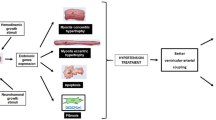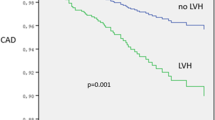Abstract
Left atrial function has an important role in determining optimal performance of the heart. Increase of left atrial dysfunction and volume are poor prognostic factors. In this study, we investigated independent determinants of left atrial function in non-diabetic patients with de novo hypertension. The study included 124 consecutive non-diabetic patients with de novo hypertension. Brachial artery flow-mediated dilatation, carotid intima-media thickness, transthoracic echocardiography, 24-h rhythm holter, and aortic stiffness measurements were recorded. In echocardiography, left atrial maximum (LAMaV) and minimum (LAMiV) volumes were calculated. Left atrium total emptying fraction (LATEF) and total emptying volume (LATEV) were divided into two groups according to the mean levels. Multivariate analysis was performed after correlation analysis for LATEV and LATEF mean levels. By logistic regression analysis, systolic blood pressure (OR 0.882, 95% CI 0.784–0.992, p = 0.036), percent of flow-mediated dilation (OR 0.747, 95% CI 0.595–0.938, p = 0.012), and presence of carotid plaque (OR 0.014, 95% CI 0.001–0.188, p = 0.001) were found as independent variables that determine LATEF. Age (OR 0.879, 95% CI 0.795–0.972, p = 0.012), smoking (OR 23.739, 95% CI 2.699–208.810, p = 0.004), left ventricular mass index (OR 1.052, 95% CI 1.012–1.094, p = 0.011), mitrale E-wave velocity (OR 1.108, 95% CI 1.031–1.191, p = 0.005) and LDL (low-density lipoprotein) cholesterol (OR 0.942, 95% CI 0.911–0.974, p = 0.001) were independent predictors of LATEV. In non-diabetic patients with de novo hypertension endothelial dysfunction, subclinical atherosclerosis and LDL cholesterol levels independently affect left atrial function.
Similar content being viewed by others
References
Williams B et al (2018) 2018 ESC/ESH Guidelines for the management of arterial hypertension: The Task Force for the management of arterial hypertension of the European Society of Cardiology and the European Society of Hypertension: The Task Force for the management of arterial hypertension of the European Society of Cardiology and the European Society of Hypertension. J Hypertens 36(10):1953–2041
To AC et al (2011) Clinical utility of multimodality LA imaging: assessment of size, function, and structure. JACC Cardiovasc Imaging 4(7):788–798
Melenovsky V et al (2007) Cardiovascular features of heart failure with preserved ejection fraction versus nonfailing hypertensive left ventricular hypertrophy in the urban Baltimore community: the role of atrial remodeling/dysfunction. J Am Coll Cardiol 49(2):198–207
Gottdiener JS et al (2006) Left atrial volume, geometry, and function in systolic and diastolic heart failure of persons > or = 65 years of age (the cardiovascular health study). Am J Cardiol 97(1):83–89
Stefanadis C, Dernellis J, Toutouzas P (2001) A clinical appraisal of left atrial function. Eur Heart J 22(1):22–36
Parmley WW (1995) Neuroendocrine changes in heart failure and their clinical relevance. Clin Cardiol 18(8):440–445
Casaclang-Verzosa G, Gersh BJ, Tsang TS (2008) Structural and functional remodeling of the left atrium: clinical and therapeutic implications for atrial fibrillation. J Am Coll Cardiol 51(1):1–11
Tsioufis C et al (2006) The interplay between haemodynamic load, brain natriuretic peptide and left atrial size in the early stages of essential hypertension. J Hypertens 24(5):965–972
Weber KT et al (1993) Myocardial fibrosis: role of angiotensin II and aldosterone. Basic Res Cardiol 88(Suppl 1):107–124
Patel DA et al (2011) Left atrial volume index predictive of mortality independent of left ventricular geometry in a large clinical cohort with preserved ejection fraction. Mayo Clin Proc 86(8):730–737
Mondillo S, Cameli M, Caputo ML, Lisi M, Palmerini E, Padeletti M et al (2011) Early detection of left atrial strain abnormalities by speckle-tracking in hypertensive and diabetic patients with normal left atrial size. J Am Soc Echocardiogr 24(8):898–908
Kojima T, Kawasaki M, Tanaka R, Ono K, Hirose T, Iwama M et al (2012) Left atrial global and regional function in patients with paroxysmal atrial fibrillation has already been impaired before enlargement of left atrium: velocity vector imaging echocardiography study. Eur Heart J Cardiovasc Imaging 13(3):227–234
Gupta S, Matulevicius SA, Ayers CR, Berry JD, Patel PC, Markham DW et al (2013) Left atrial structure and function and clinical outcomes in the general population. Eur Heart J 34(4):278–285
Hedberg P, Selmeryd J, Leppert J, Henriksen E (2017) Long-term prognostic impact of left atrial volumes and emptying fraction in acommunity-based cohort. Heart 103(9):687–693
Lang RM et al (2015) Recommendations for cardiac chamber quantification by echocardiography in adults: an update from the American Society of Echocardiography and the European Association of Cardiovascular Imaging. J Am Soc Echocardiogr 28(1):1–39
Touboul PJ et al (2012) Mannheim carotid intima-media thickness and plaque consensus (2004–2006–2011). An update on behalf of the advisory board of the 3rd, 4th and 5th watching the risk symposia, at the 13th, 15th and 20th European Stroke Conferences, Mannheim, Germany, 2004, Brussels, Belgium, 2006, and Hamburg, Germany, 2011. Cerebrovasc Dis 34(4):290–296
Schumacher W et al (2009) Association between C-reactive protein genotype, circulating levels, and aortic pulse wave velocity. Hypertension 53(2):150–157
Munir S et al (2008) Peripheral augmentation index defines the relationship between central and peripheral pulse pressure. Hypertension 51(1):112–118
Corretti MC et al (2002) Guidelines for the ultrasound assessment of endothelial-dependent flow-mediated vasodilation of the brachial artery: a report of the International Brachial Artery Reactivity Task Force. J Am Coll Cardiol 39(2):257–265
Iacobellis G et al (2003) Echocardiographic epicardial adipose tissue is related to anthropometric and clinical parameters of metabolic syndrome: a new indicator of cardiovascular risk. J Clin Endocrinol Metab 88(11):5163–5168
Blume GG et al (2011) Left atrial function: physiology, assessment, and clinical implications. Eur J Echocardiogr 12(6):421–430
Thomas L, Abhayaratna WP (2017) Left atrial reverse remodeling: mechanisms, evaluation, and clinical significance. JACC Cardiovasc Imaging 10(1):65–77
Grundy SM et al (2018) 2018 AHA/ACC/AACVPR/AAPA/ABC/ACPM/ADA/AGS/APhA/ASPC/NLA/PCNA Guideline on the Management of Blood Cholesterol: Executive Summary: A Report of the American College of Cardiology/American Heart Association Task Force on Clinical Practice Guidelines. J Am Coll Cardiol 73:285–350
Yan P et al (2014) Statin therapy decreased the recurrence frequency of atrial fibrillation after electrical cardioversion: a meta-analysis. Med Sci Monit 20:2753–2758
Hadi HA et al (2009) Pleiotropic effects of statins in atrial fibrillation patients: the evidence. Vasc Health Risk Manag 5(3):533–551
Li ZZ et al (2018) Association between blood lipid profiles and atrial fibrillation: a case–control study. Med Sci Monit 24:3903–3908
Watanabe H et al (2011) Association between lipid profile and risk of atrial fibrillation. Circ J 75(12):2767–2774
Li X et al (2018) Lipid profile and incidence of atrial fibrillation: A prospective cohort study in China. Clin Cardiol 41(3):314–320
Daiber A et al (2017) Targeting vascular (endothelial) dysfunction. Br J Pharmacol 174(12):1591–1619
Hansson GK et al (2002) Innate and adaptive immunity in the pathogenesis of atherosclerosis. Circ Res 91(4):281–291
Arenas IA et al (2004) Angiotensin II-induced MMP-2 release from endothelial cells is mediated by TNF-alpha. Am J Physiol Cell Physiol 286(4):C779–C784
Wu SJ et al (2015) Local augmented angiotensinogen secreted from apoptotic vascular endothelial cells is a vital mediator of vascular remodelling. PLoS ONE 10(7):e0132583
Espinosa-Diez C et al (2018) Role of glutathione biosynthesis in endothelial dysfunction and fibrosis. Redox Biol 14:88–99
Anderson TJ (2006) Arterial stiffness or endothelial dysfunction as a surrogate marker of vascular risk. Can J Cardiol 22(Suppl B):72B–80B
Çoner A, Gençtoy G, Akinci S, Altin C, Müderrisoğlu H (2019) Assessment of vascular inflammation and subclinical nephropathy in exaggerated blood pressure response to exercise test. Blood Press Monit. 24(3):114–119
Nambi V et al (2010) Carotid intima-media thickness and presence or absence of plaque improves prediction of coronary heart disease risk: the ARIC (Atherosclerosis Risk In Communities) study. J Am Coll Cardiol 55(15):1600–1607
Roman MJ et al (1995) Association of carotid atherosclerosis and left ventricular hypertrophy. J Am Coll Cardiol 25(1):83–90
Chahal NS et al (2010) The distinct relationships of carotid plaque disease and carotid intima-media thickness with left ventricular function. J Am Soc Echocardiogr 23(12):1303–1309
Iacobellis G, Assael F, Ribaudo MC, Zappaterreno A, Alessi G, Di Mario U, Leonetti F (2003) Epicardial fat from echocardiography: a new method for visceral adipose tissue prediction. Obes Res 11:304–310
Yamada H, Sata M (2015) Does echocardiographic epicardial adipose tissue thickness become a useful biomarker? J Atheroscler Thromb 22:555–556
Author information
Authors and Affiliations
Contributions
All authors have made substantial contributions to the conception and design of the study, acquisition of data, or analysis and interpretation; drafting the article or revising it critically for important intellectual content and final approval of the version to be submitted. All authors endorse the data and conclusions.
Corresponding author
Ethics declarations
Conflict of interest
The authors have no commercial associations or sources of support that might pose a conflict of interest.
Ehical approval
The study was performed in accordance with the principles stated in the Declaration of Helsinki and approved by the R.T.E. University Faculty of Medicine Ethics Committee.
Additional information
Publisher's Note
Springer Nature remains neutral with regard to jurisdictional claims in published maps and institutional affiliations.
Rights and permissions
About this article
Cite this article
Çetin, M., Erdoğan, T., Kırış, T. et al. Endothelial dysfunction, subclinical atherosclerosis and LDL cholesterol are the independent predictors of left atrial functions in hypertension. Int J Cardiovasc Imaging 36, 69–77 (2020). https://doi.org/10.1007/s10554-019-01699-2
Received:
Accepted:
Published:
Issue Date:
DOI: https://doi.org/10.1007/s10554-019-01699-2




